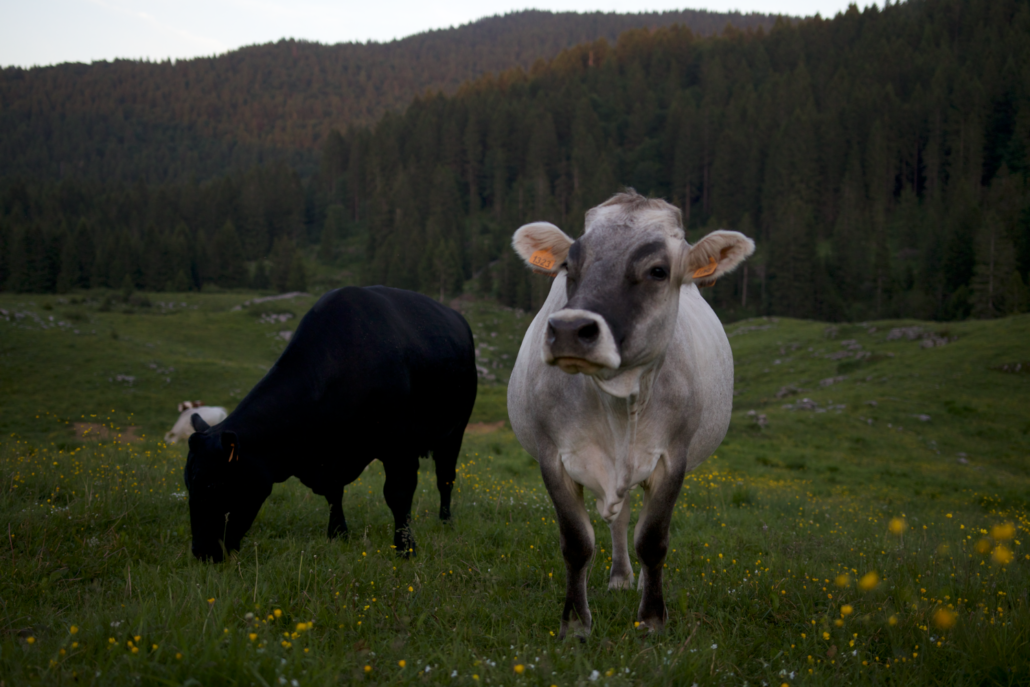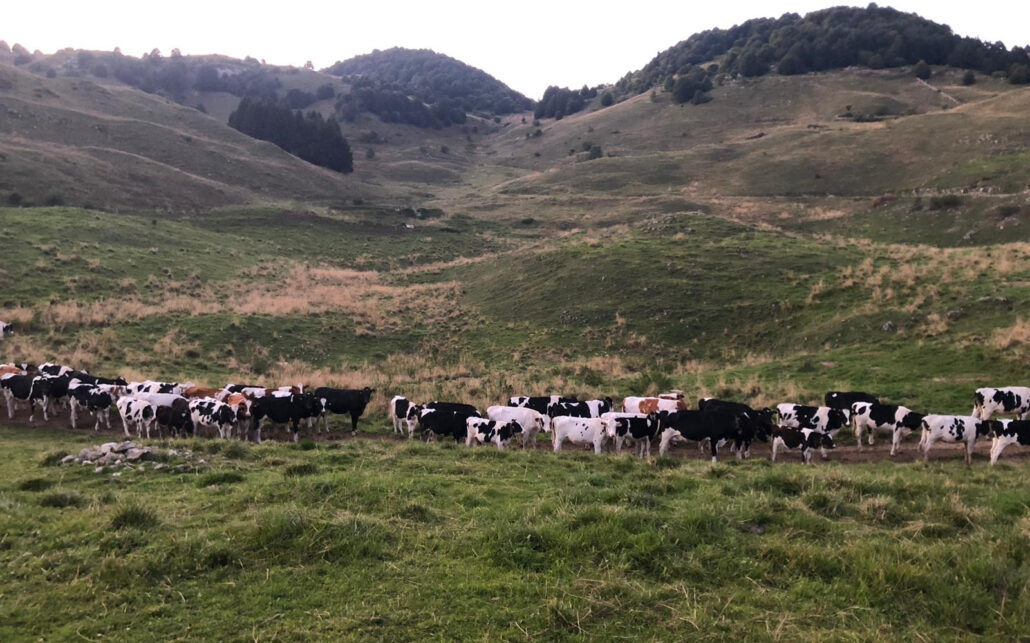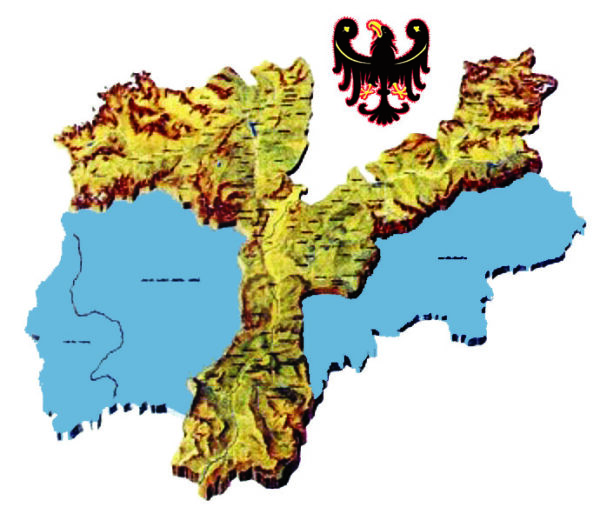December 20, 2021

In the mountains, classifying the present land-use is rather easy: what is not woodland is a meadow or pasture. However, the two often mix together because forests often take over meadows and pastures.
Pastures are defined as «forage crops of different origin and flora composition, used in part or entirely for feeding» [1]. Grazing — and in general human action —thus represents care, maintenance, and production for these areas.
«Coniferous forests, either dense or sparse, are interrupted by meadows used for mowing and/or grazing» [2]. In other words, coniferous forests are — or at the most were — managed, cut and controlled in a way that allowed traditional agricultural activities on large sections of the now densely wooded Alps. And precisely those meadows used for mowing or grazing are described by Sestini as the main method for land and landscape management. Implemented for centuries by Alpine communities, it is the only one capable of ensuring a high level of landscape diversity and, above all, biogenetic diversity. As a matter of fact, meadows are the priority habitat of several plant and animal species [3].
Rural and mountain areas abandonment has been studied and confirmed as a widespread and common phenomenon in the whole Alpine area. It occurred especially where post-war production needs could no longer depend on traditional breeding practices and labor-intensive agriculture normally practiced until the first half of the 20th century [4].
The abandonment that led to this Alpine reforestation reflects a profound crisis in rural mountain societies. Not only does it imply a loss of aesthetic, landscape and environmental qualities, but also the socio-cultural and traditional heritage of the populations that for centuries lived and managed those territories.
So what then? What should we do?
Innovative agroecological features such as farm multifunctionality, grazing rotation plans, hydraulic-agrarian-forestry systems, agroforestry, animal welfare and collaborative ethology [5] can encourage animal-plant-man integration in a perspective of sustainable production and redevelopment of mountain and inland areas.
In a modern key, agroecology can become a restoration for those traditional agricultural, zootechnical and landscape management practices that have always molded mountain areas development. For centuries performed by Alpine dwellers out of necessity, they are now included in innovative management and production systems in will.
To establish this innovation process and a modern agroecological framework, the measures here below are key.
From a socio-economic point of view: (1) a bottom-up innovation approach that includes active participation by the stakeholders; (2) project feasibility research studies and results follow-up monitoring programs; (3) stakeholders training experiences (especially for growers and breeders); (4) integration of all the environmental and production components. By adopting a systemic vision of production, the new business development models will have to include forage making and the reuse of local resources – thus cutting production costs – within their production cycle.
From a more technical point of view, mountain meadows and pasture reforestation must be contrasted through restoration and proper management. Without active management, abandonment is inevitable. There is no alternative more economically viable for such areas, which are highly limited by altitude, slope and difficulty of mechanization

Figure 1: Adequate grazing plans and correct management practices are fundamental to maintain the slope hydrogeological stability, safeguard biodiversity and contrast reforestation in mountain areas.
Courtesy of Michela Santacatterina — Malga Novegno, Schio (Vicenza)
There is a rich literature on the correct pasture management, with studies and reports considering both quantitative and qualitative production elements. Among the plenty study outcomes, the following practices are essential for a proper (traditional) agroecological pasture and livestock management: (1) correct animal load; (2) adequate grazing plans; (3) traditional weed removal without the use of synthetic plant production products; (4) extensive grazing and consideration of the marginal pasture areas; (5) use of native and hardy breeds; (6) multi-temporal grazing and simultaneous presence of more than one species; (7) ban of synthetic silage for animal feed. All these practices have a direct impact on each of the livestock production cycle components: animals, products, breeders, consumers, environment and landscape. They are a convenient entrepreneurial choice from many points of view.
The Alpine landscape we are used to is profoundly shaped by man and depends on it. The Alps witness man’s history and have given mountain communities a home for centuries. The challenge of today is to encourage and sustain new Alpine keepers, recovering the essence of Alpine areas, and the cultures, land-uses and traditions that they have supported. The goal is not to abandon them to the undaunted advance of nature, but rather make ourselves part of nature. We must return to be mountain management promoters and active mountain keepers as it happened for millennia, right here, here in the Alps.
Bibliography:
[1] Ziliotto, U. (2004). Tratti essenziali della tipologia veneta dei Pascoli di monte e Dintorni. Regione del Veneto. Direzione Regionale delle Foreste e dell’Economia Montana.
[2] Sestini, A. (1963). Il paesaggio (Vol. 7). Touring Club Italiano.
[3] Sitzia, T. & Trentanovi, G. (2012). Fisionomia e distribuzione dei prati montani (maggenghi) in 150 anni di avanzamento spontaneo del bosco (Val di Pejo, Trentino). Forest@ — Journal of Silviculture and Forest Ecology, 9 (1), 52.
[4] MacDonald, D., Crabtree, J. R., Wiesinger, G., Dax, T., Stamou, N., Fleury, P., Lazpita, J. G. & Gibon, A. (2000). Agricultural abandonment in mountain areas of Europe: environmental consequences and policy response. Journal of Environmental Management, 59 (1), 47–69.
[5] Pisseri, F. (2020). Pratiche agroecologiche per un allevamento sostenibile. Il contributo dell’Agricoltura all’Agenda dell’ONU sulla sostenibilità 2030.
Cover- and preview image: Malga Paù alm in the Asiagio highland (Vicenza, Italy). Courtesy of Giovanni Manzardo.
This article is part of the project “Environmental Blogging Boost 4 Students”, aimed at increasing the spread of agroecology and sustainable water management in Trentino. The project is financed by the BIM Adige Water Catchments Consortium (grant approved by provision n. 100 of June 06, 2021).




